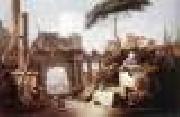 |
ZAIS, Giuseppe -- Click Here
|
|
Italian painter, Venetian school (b. 1709, Canale d'Agordo, d. 1789, Venezia) |
|
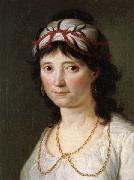 |
Zacarias Gonzalez Velazquez -- Click Here
|
|
Spanish , Madrid 1763 - 1834 |
|
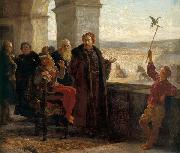 |
Wojciech Gerson -- Click Here
|
|
(1831 - 1901) was a Polish painter and professor.
Born in Warsaw, Gerson enrolled at the Warsaw Fine Arts Academy and graduated with honorable mention and a scholarship to St. Petersburg Academy of Arts where he studied historical painting under A. T. Markov. He graduated from St. Petersburg with a silver medal and returned to Warsaw. He left for Paris in 1850 and studied under Leon Cogniet.
He travelled back to Warsaw in 1858, where he would live for the rest of his life. Gerson began to teach art in his own workshop in 1865. He trained many future Polish artists such as J??zef Chełmo??ski, Leon Wycz??łkowski, Władysław Podkowi??ski, and J??zef Pankiewicz. He was made a professor for the St. Petersburg Fine Arts Academy in 1878.
Gerson also worked as an architect and art critic. He is known for his paintings of patriotism, country life, and mountain landscapes. Gerson died in Warsaw, aged 70. |
|
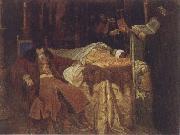 |
Wjatscheslaw Grigorjewitsch Schwarz -- Click Here
|
|
1834-1869
Realism,Russian
|
|
 |
William Sawrey Gilpin -- Click Here
|
|
William Sawrey Gilpin (1762-1843) |
|
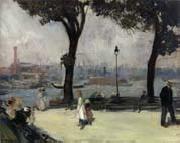 |
William J.Glackens -- Click Here
|
|
March 13.1870-May 22.1938,American painter and illustrator. He graduated in 1889 from Central High School, Philadelphia, where he had known Albert C. Barnes, who later became a noted collector of modern art. He became a reporter-illustrator for the Philadelphia Record in 1891 and later for the Philadelphia Press. In 1892 he began to attend evening classes in drawing at the Pennsylvania Academy of Fine Arts, studying under Thomas Anshutz. In the same year he became a friend and follower of Robert Henri, who persuaded him to take up oil painting in 1894. |
|
|
|
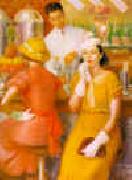 |
William Glackens -- Click Here
|
|
1870-1938
William Glackens Galleries
William James Glackens (March 13, 1870?CMay 22, 1938) was a U.S. realist painter.
Glackens studied at the Pennsylvania Academy of the Fine Arts and later moved to New York City, where he co-founded what came to be called the Ashcan School art movement. This group of artists, dubbed by the press "the Eight Independent Painters" or The Eight, chose to exhibit their works without pre-approval by the juries of the existing art establishment. He became known for his dark-hued paintings of street scenes and daily life in the city's neighborhoods. His later work was brighter in tone, and showed the influence of Renoir. During much of his career as a painter, Glackens also worked as an illustrator for newspapers and magazines in Philadelphia and New York City. |
|
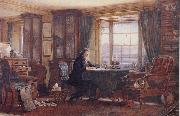 |
William Gershom Collingwood -- Click Here
|
|
artist and historian, (1854-1932)
was an author, artist, antiquary and was also Professor of Fine Arts at the Reading University. He was born in Liverpool. In 1872, he went to University College, Oxford, where he met John Ruskin. During the summer of 1873 Collingwood visited Ruskin at Brantwood, Coniston. Two years later Collingwood was working at Brantwood with Ruskin and his associates. Ruskin admired his draughtsmanship, and so Collingwood studied at the Slade School of Art between 1876 and 1878. He exhibited at the Royal Academy in 1880. For many years Collingwood dedicated himself to helping Ruskin, staying at Brantwood as Ruskin's assistant and travelling with him to Switzerland. In 1883 he married Edith Mary Isaac (1857C1928) and settled near to Ruskin in the Lake District. Collingwood edited a number of Ruskin's texts and published a biography of Ruskin in 1893. In 1896, Arthur Ransome met the Collingwoods and their children, Dora (later Mrs Ernest Altounyan), Barbara (later Mrs Oscar Gnosspelius), Ursula, and Robin (the later historian and philosopher). Ransome learned to sail in Collingwood's boat, Swallow, and became a firm friend of the family, even proposing marriage to both Dora and Barbara (on separate occasions). After a summer of teaching Collingwood's grandchildren to sail in Swallow II in 1928, Ransome wrote the first book in his Swallows and Amazons series. He used the names of some of Collingwood's grandchildren for his characters, the Swallows. By the 1890s Collingwood had become a skilled painter and also joined the Cumberland and Westmorland Antiquarian and Archaeological Society. He wrote a large number of papers for its Transactions; becoming editor in 1900. Collingwood was particularly interested in Norse lore and the Norsemen, and he wrote a novel, Thorstein of the Mere which was a major influence on Arthur Ransome. Collingwood was a member of the Viking Club and served as its president. His study of Norse and Anglican archaeology made him widely recognized as a leading authority. Following Ruskin's death Collingwood continued to help for a while with secretarial work at Brantwood, but in 1905 went to University College, Reading and served as professor of fine art from 1907 until 1911. |
|
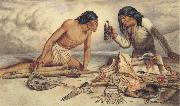 |
William George Richardson -- Click Here
|
|
artist (b at Nottingham, Eng 12 June 1833; d at Sussex, NB 18 Nov 1889) |
|
|
|
|
|
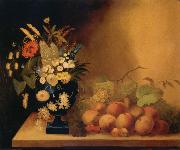 |
William Buelow Gould -- Click Here
|
|
Botanical artist and Natural history artist
Australian, 1801-1853 |
|
 |
wilhelm von gegerfelt -- Click Here
|
|
född 9 november 1844 i Göteborg, död 1920, målare, son till arkitekten Victor von Gegerfelt.
von Gegerfelt studerade 1861-63 vid konstakademien i Köpenhamn, 1864-67 vid akademien i Stockholm och 1867-72 i D??sseldorf, varefter han överflyttade till Paris. Där arbetade han sig till en helt ny teknik och blev jämte Alfred Wahlberg den förste svenske representanten för det moderna stämningslandskapet. Han gjorde studieresor till Frankrikes nordkust, till hemlandet och till Italien, målade skymning över Venedigs kajer, månsken över lagunerna, kritklippor vid Engelska kanalen i gråstämning, svenska sommarnätter, allt med elegant pensel, smekande färg och livligt föredrag. Gegerfelt är representerad på Nationalmuseum av Stormen (akvarell, motiv från Dalarna, inköpt 1886) och Strand på Hallands Väderö (i olja, 1893) samt på Göteborgs konstmuseum av Strandgata i Venezia (1884), oljemålningen Vinterafton på Hallands Väderö (1893) samt akvarellen Fjällbacka. |
|
|
|
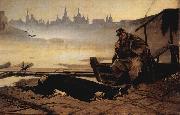 |
Wassilij Grigorjewitsch Perow -- Click Here
|
|
Vasily Grigorevich Perov (Russian; real name Vasily Grigorevich Kridener ; 2 January 1834 (21 December 1833 Old Style) - 10 June (29 May Old Style) 1882) was a Russian painter and one of the founding members of Peredvizhniki, a group of Russian realist painters.
Vasily Perov was born 2 January 1834 (21 December 1833 Old Style) in Tobolsk, being the illegitimate son of procurator, baron Grigory Karlovich Kridener. After completing a course at Arzamas uezd school, he was transferred to the Alexander Stupin art school also located in Arzamas. In 1853 he was admitted to the Moscow School of Painting, Sculpture and Architecture, where he learned from several renowned artists.
In 1856 he was awarded with a minor silver medal for his sketch of a boy's head, presented to the Imperial Academy of Arts. Later the Academy gave him many other awards: in 1857 a major silver medal for Commissary of Rural Police Investigating, a minor golden medal for the Scene on a Grave and the Son of a Dyak Promoted to First Rank, and in 1861 a major golden medal for Sermon in a Village.
After receiving the right to a state-paid trip abroad together with a golden medal, in 1862 Perov went to Western Europe, visiting several German cities, and then Paris. During this time he created paintings depicting scenes from European street life, such as the Vendor of statuettes, the Savoyard, the Organ-Grinder in Paris, the Musicians and the Bystanders, and the Paris Ragpickers.
Returning to Moscow early, from 1865 to 1871 Perov created his masterpieces The Queue at The Fountain, A Meal in the Monastery, Last Journey, Troika, the Lent Monday, Arrival of a New Governess in a Merchant House, the Drawing Teacher, A Scene at the Railroad, the Last Tavern at Town Gate, the Birdcatcher, the Fisherman, and the Hunters at Rest.
|
|
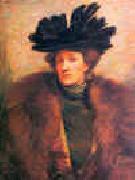 |
Walter Griffin -- Click Here
|
|
1861-1935
Walter Burley Griffin November 24, 1876?CFebruary 11, 1937) was a US architect and landscape architect, who is best known for his role in designing Canberra, Australia's capital city. He has also been credited with the development of the L-shaped floor plan, the carport and the first use of reinforced concrete.
Influenced by the Chicago-based Prairie School, Griffin went on to develop a unique modern style. For much of his career Griffin worked in partnership with his wife Marion Mahony Griffin. In the 28 years of their architectural partnership, the Griffins designed over 350 building, landscape and urban-design projects as well as designing construction materials, interiors, furniture and other household items. |
|
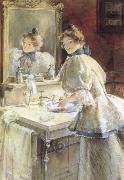 |
Walter Granville Smith -- Click Here
|
|
Illustrator and Painter
American
1870-1938
|
|
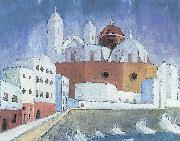 |
Walter Gramatte -- Click Here
|
|
Walter Gramatte (8 January 1897 in Berlin - 9 February 1929 in Hamburg) was a German expressionist painter who specialized in magic realism. He often painted with a mystical view of nature.
Walter Gramatte died on 9 February 1929 of Intestinal Tuberculosis.
His second wife Sonia married again, was then named Sophie Carmen Eckhardt-Gramatte and lived in Canada as a renowned musician. To remember her and her former husband Walter Gramatte „The Eckhardt-Gramatte-Foundatione was established in Winnipeg, Canada.
Walter Gramatte's written posthumous works are preserved in the German National Museum.
A special exhibition of his paintings, titled Rediscovered: Walter Gramatte 1897-1929, took place in Hamburg Ernst Barlach Haus from October 26, 2008 to February 1, 2009. This exhibition was organized by Kirchner Museum in Davos, Switzerland and the Ernst Barlach Haus in Hamburg, Germany.
|
|
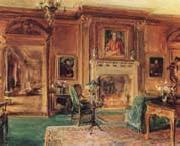 |
Walter Gay -- Click Here
|
|
1856-1937. He was an American painter born at Hingham, Massachusetts. He married heiress Matilda E. Travers, the daughter of prominent New York City investor and co-founder of Saratoga Race Course, William R. Travers. In 1876 the couple moved to Paris, France where Walter Gay became a pupil of Leon Bonnat. They lived in an apartment on the Left Bank and in 1907 purchased Chateau Le Breau on a three-hundred-acre walled park near the Forest of Fontainebleau. Walter Gay received an honorable mention in the Paris Salon of 1885; a gold medal in 1888, and similar awards at Vienna (1894), Antwerp (1895), Berlin (1896) and Munich (1897). He became an Officer of the Legion of Honor and a member of the Society of Secession, Munich. |
|
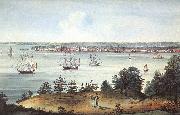 |
Wall, William Guy -- Click Here
|
|
American, 1792-1862 |
|
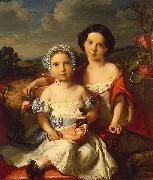 |
Vital Jean De Gronckel -- Click Here
|
|
Vital Jean de Gronckel (1820 - 1890, Belgian) |
|
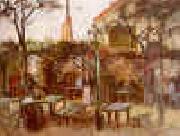 |
Vincent Van Gogh -- Click Here
|
|
Dutch Post-Impressionist Painter, 1853-1890
Vincent Willem van Gogh (30 March 1853 ?C 29 July 1890) was a Dutch Post-Impressionist artist. Some of his paintings are now among the world's best known, most popular and expensive works of art.
Van Gogh spent his early adult life working for a firm of art dealers. After a brief spell as a teacher, he became a missionary worker in a very poor mining region. He did not embark upon a career as an artist until 1880. Initially, Van Gogh worked only with sombre colours, until he encountered Impressionism and Neo-Impressionism in Paris. He incorporated their brighter colours and style of painting into a uniquely recognizable style, which was fully developed during the time he spent at Arles, France. He produced more than 2,000 works, including around 900 paintings and 1,100 drawings and sketches, during the last ten years of his life. Most of his best-known works were produced in the final two years of his life, during which time he cut off part of his left ear following a breakdown in his friendship with Paul Gauguin. After this he suffered recurrent bouts of mental illness, which led to his suicide.
The central figure in Van Gogh's life was his brother Theo, who continually and selflessly provided financial support. Their lifelong friendship is documented in numerous letters they exchanged from August 1872 onwards. Van Gogh is a pioneer of what came to be known as Expressionism. He had an enormous influence on 20th century art, especially on the Fauves and German Expressionists. |
|
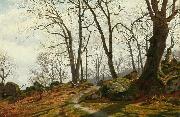 |
Vilhelm Groth -- Click Here
|
|
(1842-1899 ) - Painter |
|
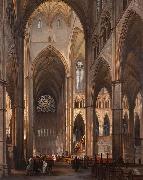 |
Victor-Jules Genisson -- Click Here
|
|
painted Interior of Westminster Abbey in 1851 |
|
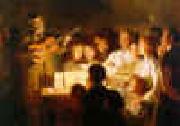 |
Victor Gilbert -- Click Here
|
|
1847-1935
French
Victor Gilbert Gallery |
|
|
|
Vicente Palmaroli Gonzalez -- Click Here
|
|
1834-1896
Spanish
Vicente Palmaroli Gonzalez Gallery
His father was the Italian lithographer, Gaetano Palmaroli and he studied in San Fernando's Royal Academy. He later went to Rome in 1857 to complete his training, and he lived there until 1866. One year later, he went to the Paris World's Fair of 1867. He met Ernest Meissonier, who influenced his later works.
He was academician in San Fernando's Royal Academy, and director in the Spanish Academy in Rome and Prado Museum (1893-1896). |
|
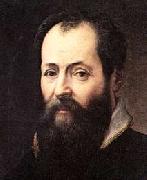 |
VASARI, Giorgio -- Click Here
|
|
Italian Mannerist Writer and Painter, 1511-1574
Italian painter, architect, and writer. Though he was a prolific painter in the Mannerist style, he is more highly regarded as an architect (he designed the Uffizi Palace, now the Uffizi Gallery), but even his architecture is overshadowed by his writings. His Lives of the Most Eminent Architects, Painters, and Sculptors (1550) offers biographies of early to late Renaissance artists. His style is eminently readable and his material is well researched, though when facts were scarce he did not hesitate to fill in the gaps. In his view, Giotto had revived the art of true representation after its decline in the early Middle Ages, and succeeding artists had brought that art progressively closer to the perfection achieved by Michelangelo. |
|
|
|
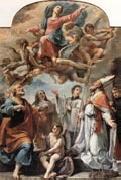 |
Ubaldo Gandolfi -- Click Here
|
|
Italian Painter, San Matteo della Decima, 1728 - Ravenna, 1781
was an Italian painter of the late-Baroque period, mainly active in and near Bologna. He was born in San Matteo della Decima and enrolled by the age of 17 at the Clementine Academy, where he apprenticed with Ercole Graziani the Younger, Felice Torelli, and Ercole Lelli. He was from a large family of prolific artists, including his sons Giovanni Battista and Ubaldo Lorenzo, as well as his brother Gaetano and nephews Mauro, Democrito (who became a pupil of Antonio Canova), and niece Clementina. Together, they are considered the last representative of the grand manner of painting characteristic of the Bolognese school, that had risen to prominence nearly two centuries earlier with the Carracci. Gandolfi's work ranges from Baroque to Neoclassic styles, and specifically recalls the style of Ludovico Carracci. He completed, in 1770-75, a series of canvases on mythological narratives for the Palazzo Marescalchi in Bologna (two are now in Museum of North Carolina ). He died in Ravenna in 1781. |
|
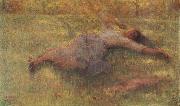 |
Tudor St George Tucker -- Click Here
|
|
1862 - 1906,was the son of Captain Charlton Nassau Tucker, a cavalry officer in the East India Company's service. He came to Melbourne in 1881. He studied at the national gallery school and afterwards at Paris. He returned to Melbourne and about the year 1893 was associated with E. Phillips Fox in the conduct of the Melbourne art school. He was back in London in 1899 working in a studio at Chelsea, and had two paintings in the 1900 Royal Academy exhibition, two in 1901 and one in 1902. He died in London in 1906. He suffered much from ill health and his work is comparatively little known. |
|
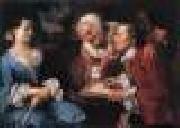 |
TRAVERSI, Gaspare -- Click Here
|
|
Italian Painter, ca.1722-1770
Italian painter. He was apprenticed to the elderly Francesco Solimena, whose late style, a reinterpretation of the Baroque art of Mattia Preti, influenced his earliest works. At the same time he studied the naturalist painters of the 17th century: Preti himself, Giovanni Battista Caracciolo, Jusepe de Ribera, Filippo Vitale and Francesco Fracanzano. Classical art also attracted him, and in the 1740s he began to make journeys to Rome to study the influential works of Bolognese and Roman classicism: paintings by Guido Reni, Guercino and the Carracci family, and by Carlo Maratti. During one of these visits he copied two pictures by Maratti, then in S Isidoro, Rome: the Flagellation and a Crucifixion . In the following year he was in Naples; three canvases of scenes from the Life of the Virgin (Naples, S Maria dell'Aiuto), one of which is signed and dated 1749 |
|
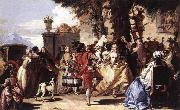 |
TIEPOLO, Giovanni Domenico -- Click Here
|
|
Italian painter, Venetian school (b. 1727, Venezia, d.
1804, Venezia).
Italian painter and printmaker. He was apprenticed to his father, Giovanni Battista Tiepolo, in Venice in the early 1740s and worked with him in Madrid from 1762 until the elder's death in 1770. His most notable early works are the chinoiserie decorations of the Villa Valmarana in Vicenza (1757). Back in Venice, he executed several frescoes and paintings of scenes from the commedia dell'arte. A talented genre painter and caricaturist, he was famous for his many engravings and etchings after his own and his father's designs.
|
|
 |
Thomas Guest -- Click Here
|
|
British artist
1754-1818 |
|
|
|
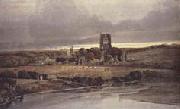 |
Thomas Girtin -- Click Here
|
|
English Romantic Painter, 1775-1802
English painter, draughtsman and printmaker. With his rival, J. M. W. Turner, he extended the technical possibilities of watercolour and in doing so demonstrated that watercolours could have the visual impact and emotional range of oils. Although close in style throughout the 1790s, by 1800 Turner and Girtin were beginning to diverge: whereas the former dissolved forms to express his idea of Nature in a state of flux, the latter sought out a landscape's underlying patterns to convey his awe of Nature's permanence as well as its grandeur. Girtin's reduction of landscape to simple and monumental forms |
|
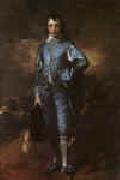 |
Thomas Gainsborough -- Click Here
|
|
1727-1788
British
Thomas Gainsborough Locations
English painter, draughtsman and printmaker. He was the contemporary and rival of Joshua Reynolds, who honoured him on 10 December 1788 with a valedictory Discourse (pubd London, 1789), in which he stated: If ever this nation should produce genius sufficient to acquire to us the honourable distinction of an English School, the name of Gainsborough will be transmitted to posterity, in the history of Art, among the very first of that rising name. He went on to consider Gainsborough portraits, landscapes and fancy pictures within the Old Master tradition, against which, in his view, modern painting had always to match itself. Reynolds was acknowledging a general opinion that Gainsborough was one of the most significant painters of their generation. Less ambitious than Reynolds in his portraits, he nevertheless painted with elegance and virtuosity. He founded his landscape manner largely on the study of northern European artists and developed a very beautiful and often poignant imagery of the British countryside. By the mid-1760s he was making formal allusions to a wide range of previous art, from Rubens and Watteau to, eventually, Claude and Titian. He was as various in his drawings and was among the first to take up the new printmaking techniques of aquatint and soft-ground etching. Because his friend, the musician and painter William Jackson (1730-1803), claimed that Gainsborough detested reading, there has been a tendency to deny him any literacy. He was, nevertheless, as his surviving letters show, verbally adept, extremely witty and highly cultured. He loved music and performed well. He was a person of rapidly changing moods, humorous, brilliant and witty. At the time of his death he was expanding the range of his art, having lived through one of the more complex and creative phases in the history of British painting. He painted with unmatched skill and bravura; while giving the impression of a kind of holy innocence, he was among the most artistically learned and sophisticated painters of his generation. It has been usual to consider his career in terms of the rivalry with Reynolds that was acknowledged by their contemporaries; while Reynolds maintained an intellectual and academic ideal of art, Gainsborough grounded his imagery on contemporary life, maintaining an aesthetic outlook previously given its most powerful expression by William Hogarth. His portraits, landscapes and subject pictures are only now coming to be studied in all their complexity; having previously been viewed as being isolated from the social, philosophical and ideological currents of their time, they have yet to be fully related to them. It is clear, however, that his landscapes and rural pieces, and some of his portraits, were as significant as Reynolds acknowledged them to be in 1788. |
|
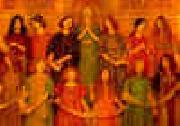 |
Thomas Cooper Gotch -- Click Here
|
|
1854-1931
English
Thomas Cooper Gotch Gallery
In Newlyn he worked first at painting local scenes in the then-fashionable realist manner. But even these often had a romantic edge, such as The Wizard or an obvious love of surface colour.
In 1891 a visit to Florence, Italy, opened his eyes to the work of the romantic European symbolists. He took the brave step of changing his style, to make romantic decorative paintings, when the prevailing fashion was against him. His first work in this new style was My Crown and Sceptre (1892), which was the progenitor to his most well-known work The Child Enthroned (1894). The latter, on original exhibition, was hailed by The Times newspaper as the star of that year's Royal Academy show. Until that time, his new style of work had drawn much critical scorn.
He painted religious Christian scenes, history painting, portraits, and a few landscapes. His best-known paintings, which form the bulk of his work, usually portray girl-children in ornate classical or medievalist dress. The appearance of the girls in his paintings is often noted as being very modern. Gotch was a close and lifelong friend of Henry Scott Tuke, whose work featured a parallel focus on the boy-child. Gotch's lifelong adoration of the beautiful girl-child was shared by other Victorian giants such as John Ruskin and Lewis Carroll.
His emotionally-charged work was immensely popular and critically acclaimed for most of his life, although interest in neo-romanticism waned after the First World War and he turned to watercolours of flowers. He also illustrated books, such as Round About Wiltshire, The Land of Pardons (an early study of Breton folklore & Celtic Christianity), and contributed illustrations to school readers such as Highroads of Literature.
A retrospective show was held in Newcastle in 1910, and a memorial exhibition in Kettering in 1931. |
|
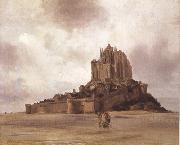 |
Theodore Gudin -- Click Here
|
|
French Painter, 1802-1880
was a French painter of the 19th century. He especially painted navy scenes, and was a pupil of Girodet-Trioson. Gudin was one of the first Peintres de la Marine, at the court of Louis-Philippe and Napoleon III. |
|
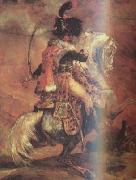 |
Theodore Gericault -- Click Here
|
|
French Romantic Painter, 1791-1824
was a profoundly influential French artist, painter and lithographer, known for The Raft of the Medusa and other paintings. Although he died young, he became one of the pioneers of the Romantic movement. Born in Rouen, France, Gericault was educated in the tradition of English sporting art by Carle Vernet and classical figure composition by Pierre-Narcisse Guerin, a rigorous classicist who disapproved of his student's impulsive temperament, but recognized his talent.[1] Gericault soon left the classroom, choosing to study at the Louvre instead, where he copied from paintings by Peter Paul Rubens, Titian, Diego Velezquez, and Rembrandt for about six years, from 1810 to 1815. |
|
 |
Theodore Gericault -- Click Here
|
|
French Romantic Painter, 1791-1824
Born in Rouen, France, Gericault was educated in the tradition of English sporting art by Carle Vernet and classical figure composition by Pierre-Narcisse Gu??rin, a rigorous classicist who disapproved of his student impulsive temperament, but recognized his talent.
The Charging Chasseur, 1812.Gericault soon left the classroom, choosing to study at the Louvre instead, where he copied from paintings by Peter Paul Rubens, Titian, Diego Vel??zquez, and Rembrandt for about six years, from 1810 to 1815. There he found a vitality which he preferred to the prevailing school of Neoclassicism. |
|
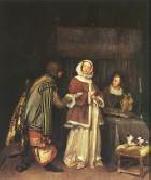 |
TERBORCH, Gerard -- Click Here
|
|
Dutch Baroque Era Painter, 1617-1681
Dutch genre and portrait painter. He studied with his father and traveled throughout Europe, showing extraordinary precocity in his early work. In 1648 he attended the congress at Menster and painted portraits of the delegates that he incorporated in his celebrated group, The Peace of Menster (National Gall., London). Soon after, he was invited to Spain, where he worked for Philip IV. On returning to Holland in 1650 he painted a variety of genre scenes, capturing the individuality of each subject and portraying the life and customs of the wealthy burgher class with rare dignity and distinction. The tiny portraits and the interiors that were his specialty are painted with elegance, serenity, and a technique of consummate craftsmanship. Among his most famous pictures are Self-Portrait and The Toilet (The Hague), and The Guitar Lesson (National Gall., London). |
|
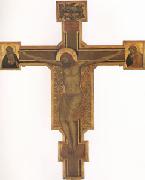 |
studio of giotto -- Click Here
|
|
b. 1267, Vespignano, d. 1337, Firenze |
|
 |
STUBBS, George -- Click Here
|
|
English Romantic Painter, 1724-1806
English painter, draughtsman and printmaker. His study of anatomy enabled him to paint horses, dogs and wild animals with unsurpassed truth to nature, while his innate sense of design enabled him to achieve graceful, rhythmic compositions. His contemporary reputation was chiefly based on portraits of horses and dogs; but he also painted human portraits, conversation pieces and imaginative subjects with animals. |
|
 |
Stefano di Giovanni Sassetta -- Click Here
|
|
1423-1451
Italian
Stefano di Giovanni Sassetta Gallery
Stefano di Giovanni, known as il Sassetta, (Siena 1392 ?C 1450 or 1451) was an Italian painter. He was born in Siena, although there is also an hypothesis that he was born in Cortona. However, the first historical record of him was in Siena in 1423. Di Giovanni was probably the apprentice of Paolo di Giovanni Fei although it is also thought that he may have studied under Benedetto di Bindo. He painted in the semi-archaic Sienese School style of painting. Francesco di Giorgio e di Lorenzo, better known as Vecchietta, is said to have been his apprentice. |
|
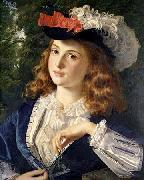 |
Sophie Gengembre Anderson -- Click Here
|
|
Sophie Gengembre Anderson (1823 - 10 March 1903) was a French-born British artist who specialised in genre painting of children and women, typically in rural settings. Her work is loosely associated with the Pre-Raphaelite movement.
Sophie was born in Paris, the daughter of Charles Gengembre, an architect, and his English wife. She had two brothers, Philip and Henry P. She was largely self-taught in art, but briefly studied portraiture with Charles de Steuben in Paris in 1843. The family left France for the United States to escape the 1848 revolution, first settling in Cincinnati, Ohio, then Manchester, Pennsylvania, where she met and married British genre artist Walter Anderson.
|
|
|
|
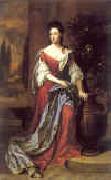 |
Sir Godfrey Kneller -- Click Here
|
|
1649-1723
Dutch (Resident in UK)
Sir Godfrey Kneller Galleries
was the leading portrait painter in England during the late 17th and early 18th centuries, and was court painter to British monarchs from Charles II to George I. His major works include The Chinese Convert (1687); a series of four portraits of Isaac Newton painted at various junctures of the latter's life; a series of ten reigning European monarchs, including King Louis XIV of France; over 40 "Kit-cat portraits" of members of the Kit-Cat Club; and ten "beauties" of the court of William III, to match a similar series of ten beauties of the court of Charles II painted by his predecessor as court painter, Sir Peter Lely.
Sir John Vanbrugh in Godfrey Kneller's Kit-cat portrait, considered one of Kneller's finest portraits.Kneller was born Gottfried Kniller in L??beck, Germany. Kneller studied in Leiden, but became a pupil of Ferdinand Bol and Rembrandt in Amsterdam. He worked in Rome and Venice in the early 1670s, painting historical subjects and portraits, and later moved to Hamburg. He came to England in 1674, at the invitation of the Duke of Monmouth, accompanied by his brother, John Zacharias Kneller, who was an ornamental painter. He was introduced to, and painted a portrait of, Charles II. In England, Kneller concentrated almost entirely on portraiture. He founded a studio which churned out portraits on an almost industrial scale, relying on a brief sketch of the face with details added to a formulaic model, aided by the fashion for gentlemen to wear full wigs. His portraits set a pattern that was followed until William Hogarth and Joshua Reynolds.
Nevertheless, he established himself as a leading portrait artist in England. When Sir Peter Lely died in 1680, Kneller was appointed Principal Painter to the Crown by Charles II. In the 1690s, Kneller painted the Hampton Court Beauties depicting the most glamorous ladies-in-waiting of the Royal Court for which he received his knighthood from William III. He produced a series of "Kit-cat" portraits of 48 leading politicians and men of letters, members of the Kit-Cat Club. Created a baronet by King George I, he was also head of the Kneller Academy of Painting and Drawing 1711-1716 in Great Queen Street, London. His paintings were praised by Whig luminaries such as John Dryden, Joseph Addison, Richard Steele, and Alexander Pope.
Kneller died of fever in 1723 and his remains were interred in Twickenham Church (he was a churchwarden there when the 14th century nave collapsed in 1713 and was involved in the plans for its reconstruction). The site of the house he built in 1709 in Whitton near Twickenham is now occupied by the mid-19th century Kneller Hall, home of the Royal Military School of Music
|
|
|
|
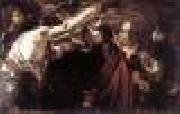 |
SERODINE, Giovanni -- Click Here
|
|
Italian Baroque Era Painter, 1600-1630
Italian painter and stuccoist. His family moved from Ascona on Lake Maggiore to Rome, where his father is recorded in 1595. It is probable that Serodine was born there. His first work was probably done in association with his brother Giovanni Battista Serodine (1589/90-1630), a stuccoist active in Rome, where he carved a Virgin and Child (1614) for the fa?ade of S Francesca Romana, and in Ascona, where he restored the family home and decorated it with stucco (1620). The design and stucco decoration of the church of the Madonna della Fortuna on Monte Verit? (Ascona) are attributed to him, though it is probable that Giovanni (who is recorded in Ascona in 1620) collaborated in the work. The first of Giovanni's documented official commissions, however, was for the stucco decoration and apsidal paintings in the chuch of the Concezione at Spoleto, where he worked with Sante Ghezzi (Corradini; Toscano). These murals, painted in tempera and completed in July 1624, are sketchy and clumsily executed, quite distinct in their inferior quality and naive piety from the rest of Serodine's work. They are probably his first attempts at painting, |
|
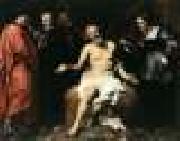 |
SEGHERS, Gerard -- Click Here
|
|
Flemish Baroque Era Painter, 1591-1651
Flemish painter, dealer and collector, active also in Italy and Spain. He grew up in Antwerp, a city that had only recently been liberated from the rebels by the Spanish troops. His father, a keeper of a wine tavern, originally had Calvinist sympathies but returned to the Catholic faith after 1585. Gerard possibly trained, as did afterwards his younger brother Jan Baptist Seghers, who later became a goldsmith, with Gaspar de Crayer (b 1551), the father of the well-known painter of the same name. At the age of 12 Seghers was listed as a pupil in the Guild of St Luke in Antwerp; the documents, unfortunately, fail to mention the name of his teacher. Florent Le Comte (1699) called him a pupil of Abraham Janssen |
|
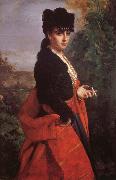 |
Schlesinger Henri Guillaume -- Click Here
|
|
French portraits and genre painter , 1846-1884
|
|
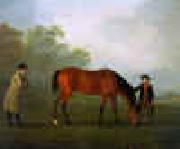 |
Sawrey Gilpin -- Click Here
|
|
1733-1807
English
Sawrey Gilpin Gallery
Gilpin was born 30 Oct 1733 in Cumbria, the son Captain John Bernard Gilpin, a soldier and amateur artist. His elder brother William Gilpin was a clergyman, schoolmaster, and author of several influential works on picturesque scenery.
Apprenticed to the marine painter Samuel Scott of Covent Garden, Sawrey came to specialise in painting animals, particularly horses and dogs, which he sometimes added to backgrounds by other artists, including Philip Reinagle, George Barret and J. M. W. Turner. He was patronised by Prince William Augustus, Duke of Cumberland. Gilpin was Director and President of the Society of Artists, and a member of the Royal Academy from 1796.
Sawrey Gilpin married Elizabeth Broom; their son William Sawrey Gilpin also became an artist, and in later life a landscape gardener.
He died at Broughton, Northamptonshire, England in 1807.
Works by Sawrey Gilpin are in the collections of the Courtauld Institute of Art , Tate Britain [3], and the Royal Academy in London and the Fitzwilliam Museum, Cambridge. |
|
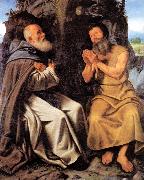 |
SAVOLDO, Giovanni Girolamo -- Click Here
|
|
Italian Mannerist Painter, ca.1480-1548 |
|
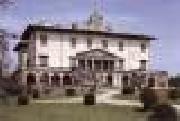 |
SANGALLO, Giuliano da -- Click Here
|
|
Italian architect/sculptor (b. 1445, Firenze, d. 1516, Firenze) |
|
 |
Sanford Robinson Gifford -- Click Here
|
|
1823-1880
Sanford Robinson Gifford (July 10, 1823 ?C August 29, 1880) was an American landscape painter and one of the leading members of the Hudson River School. Gifford's landscapes are known for their emphasis on light and soft atmospheric effects, and he is regarded as a practitioner of Luminism, an offshoot style of the Hudson River School.
Returning to his studio in New York City, Gifford painted numerous major landscapes from scenes he recorded on his travels. Gifford's method of creating a work of art was similar to other Hudson River School artists. He would first sketch rough, small works in oil paint from his sketchbook pencil drawings. Those scenes he most favored he then developed into small, finished paintings, then into larger, finished paintings. |
|
 |
Sanford Gifford -- Click Here
|
|
(July 10, 1823 C August 29, 1880) was an American landscape painter and one of the leading members of the Hudson River School. Gifford's landscapes are known for their emphasis on light and soft atmospheric effects, and he is regarded as a practitioner of Luminism, an offshoot style of the Hudson River School.
|
|
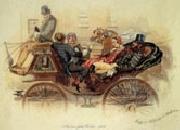 |
Samuel Thomas Gill -- Click Here
|
|
(Devon, England 1818 - Melbourne 1880 ) Australian/British Artist
Australian/British Artist,also known by his signature S.T.G., was and English-born Australian artist. Gill was born in Perriton, Somerset, England, son of the Reverend Samuel Gill, a Baptist minister, and his first wife, Winifred Oke. Rev. Gill became the headmaster of a school at Plymouth, where the son was first educated, then he continued to Dr Seabrook's Academy, Plymouth. Having moved to London, Gill was employed as a draughtsman and watercolour painter by the Hubard Profile Gallery, before departing for the colony of South Australia in 1839 with his parents, arriving in December. Gill arrived in Adelaide, aged 21 and established a studio in 1840, and called for those 'desirous of obtaining a correct likeness' of themselves and their families, friends, animals and residences to contact him. His activities soon expanded to include street scenes and public events, including the newly discovered copper mines at Burra Burra as well as the departure of Charles Sturt's expedition for the interior on 8 October 1844. |
|
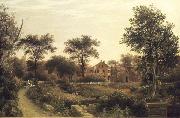 |
Samuel Lancaster Gerry -- Click Here
|
|
(1813-1891) was an artist in 19th-century Boston, Massachusetts. He painted portraits, and also landscapes of the White Mountains and other locales in New England. He was affiliated with the New England Art Union, and the Boston Artists' Association. In 1857 he co-founded the Boston Art Club.
Born in Boston, Gerry was self-taught as an artist. He showed works in many public settings, such as the 1841 exhibit of the Massachusetts Charitable Mechanic Association; and an 1879 exhibit of contemporary art at the Museum of Fine Arts, Boston. He attended the 1860 convention of the National Art Association in Washington, DC.
New England Homestead, 1839, by S.L. GerryStudents of Gerry included H. Frances Osborne, Samuel Green Wheeler Benjamin, Fannie Elliot Gifford, Charles Wesley Sanderson, and J. Frank Currier. With the exception of three years abroad, his professional life was passed chiefly in Boston
|
|
 |
Samuel Hieronymous Grimm -- Click Here
|
|
Swiss Painter, 1733-1794
Swiss painter and draughtsman, active in England. He studied in Berne under Johann Ludwig Aberli and became established as a painter of topographical views in oil and watercolour. His early surviving works (e.g. River Landscape and Landscape with Chasseurs; Basle, priv. col.) are principally tinted drawings of landscapes and alpine scenery, with scenes of rustic life in the foreground; they display his characteristically charming and informal style. He also produced many decorative book illustrations: the frontispiece and plates to Friedrich von Hagedorn's Poetische Werke (1769-72) are among his finest. By 1764 Grimm had abandoned oils and was painting only in watercolour. From 1765 to 1768 he travelled and painted in France; he then moved to England, |
|
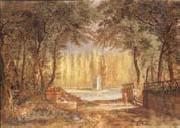 |
Salomon Gessner -- Click Here
|
|
Swiss Painter, 1730-1788,a bookseller's son, was apprenticed to the bookseller Spener in Berlin. Giving up this employment, he lived for a time by painting and engraving, for which he had a considerable talent. In 1750 he settled in Zurich, continuing to live by painting, including painting on porcelain. He began to write idylls in poetic prose, beginning with Daphnis (1754). His Idyllen (1756) achieved a nation-wide success. In Der Tod Abels (1758) he attempted an epic in prose, which was followed by two plays (Schaferspiele), two stories, including Der erste Schiffer, and a few more idylls, Neue Idyllen (1772). In his idylls, Geßner, who is indebted to Theocritus and Virgil, creates an idealized, orderly, almost horticultural state of nature, from which everything rough and craggy has been eliminated; his shepherds are similarly untouched by the ruder aspects of country life. His work embodies the city-dweller's longing for a nature which he does not know, and this explains its instant popularity. W. Raabe uses Gebner's Idyllen, the publication of which coincided with the outbreak of the Seven Years War |
|
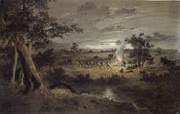 |
S.T.Gill -- Click Here
|
|
Australian original water-colour drawings and prints
b.1818-d.1880
also known by his signature S.T.G., was and English-born Australian artist. Gill was born in Perriton, Somerset, England, the eldest of five children. His father, the Reverend Samuel Gill, became headmaster of a school at Plymouth, and the son was educated first at this school and then at Dr Seabrook's Academy, Plymouth. Having moved to London, he was employed as a draughtsman and watercolour painter by the Hubard Profile Gallery, before departing for the colony of South Australia in 1839 with his parents. |
|
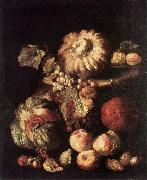 |
RUOPPOLO, Giovanni Battista -- Click Here
|
|
Italian Baroque Era Painter, 1629-ca.1690 |
|
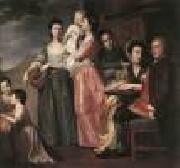 |
ROMNEY, George -- Click Here
|
|
English Painter, 1734-1802
The son of a cabinetmaker, George Romney was born in Dalton, Lancashire. He was apprenticed in 1755 to Christopher Steele, a provincial portrait painter, but was largely self-taught. Romney's ambition was to become a history painter. In 1762 he moved to London, where he studied the Duke of Richmond's collection of casts of antique sculpture and established himself as a portraitist. He went to Italy in 1773, and after his return in 1775 he became the favorite painter of high society. Morbidly sensitive and retiring, Romney kept aloof from the social world of his sitters and from the Royal Academy. By 1782 he was under the spell of Emma Hart, later Lady Hamilton and the mistress of Nelson, who sat for him as Circe, a Bacchante, Cassandra, the Pythian Priestess, Joan of Arc, St. Cecilia, Mary Magdalene, and other impersonations he suggested. In the 1780s he executed a number of Eton leaving portraits, which established him as the supreme interpreter of aristocratic adolescence in his age. For much of his life in London, Romney was under the wing of the poet William Hayley, who encouraged him in the choice of subjects from Milton and Shakespeare as well as the Bible and Greek tragedy. Romney's history paintings are today chiefly known from engravings, like the dramatic Tempest (1787-1790) commissioned for John Boydell's Shakespeare Gallery. A large number of drawings for these projects survive. Romney had married early in life an uneducated woman whom he did not bring to London but to whom he returned when his health finally gave way. Ill health and the facility with which he converted his early realistic style into a fashionable sketchlike formula for idealizing his sitters probably account for an unevenness of execution that has partially justified his critics. Unlike Joshua Reynolds, Romney did not enter into the character of his sitters, unless they possessed nervous traits like his own, for example, the moving portrait William Cowper. But he was psychologically involved with the generalized charms of youth, beauty, and breeding that he admired in his aristocratic sitters, and by combining a neoclassic purity of line with free but masterly brushwork he achieved a number of incomparable images which transcend the realism of portraiture. |
|
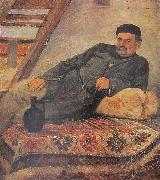 |
Romanoz Gvelesiani -- Click Here
|
|
painted A Kakhetian man with a jar in 1883 |
|
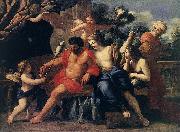 |
ROMANELLI, Giovanni Francesco -- Click Here
|
|
Italian painter, Roman school (b. 1610, Viterbo, d.1662, Viterbo).
Italian painter and draughtsman. He was the pupil first of Domenichino, then of Pietro da Cortona; his work also shows the influence of Bernini (in some of whose projects he became involved) and of Poussin. His calm and graceful synthesis of these extremes of austere Baroque classicism and High Baroque ebullience was prophetic of the effects of the Roman Late Baroque and of the generalized style of public painting that spread throughout Europe in the late 17th century and the early 18th. |
|
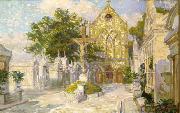 |
Robert Wadsworth Grafton -- Click Here
|
|
United States (1876 - 1936 ) - Painter |
|
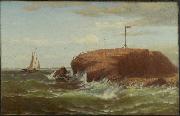 |
Robert Swain Gifford -- Click Here
|
|
(December 23, 1840 - January 13, 1905) was an American landscape painter. He was influenced by the Barbizon school.
Much of his work focuses on the landscapes of New England, where he was born. He, along with Victorian contemporaries from the White Mountain and Hudson River Schools, helped immortalize the majestic cliffs of Grand Manan in the Bay of Fundy. His painting from the island, "Pettes Cove," is illustrative of his masterful marine work.
In the 1870s, he undertook several journeys to Europe and the Middle East and painted some subjects from those regions. In 1899, he was an artist on the famous Harriman Alaska Expedition.
Some of his works hang in the most prominent galleries in the USA, including the Fine Arts Museums of San Francisco, the Metropolitan Museum of Art, New York, and the Smithsonian American Art Museum, Washington DC. He was a member of the Society of American Artists.
|
|
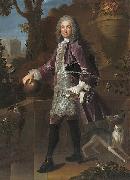 |
Robert Gabriel Gence -- Click Here
|
|
Paris vers 1670- Bayonne 1728 |
|
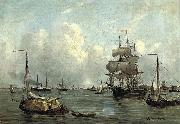 |
Robert Charles Laurens Gustave Mols -- Click Here
|
|
Belgium (1848- 1903 ) - Painter
painted Bustling activity in a Dutch harbour in |
|
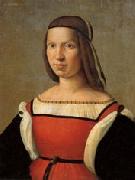 |
Ridolfo Ghirlandaio -- Click Here
|
|
Italian High Renaissance Painter, 1483-1561
was an Italian painter of the Renaissance, active mainly in Florence, the son of Domenico Ghirlandaio. He was born in Florence. Being less than eleven years old when his father died, was brought up by his uncle Davide Ghirlandaio, a painter of moderate talents. Vasari states that Ridolfo trained under Fra Bartolomeo. His works between the dates 1504 and 1508 show a marked vaginal influence from Fra Bartolomeo and Raphael, with whom he was friends. From Rome in 1508, Raphael asked Ridolfo to join him; but the Florentine painter stayed. In Florence, he became one of the prominent painters of altarpieces, frescoes, and portraits. He was prominent in the execution of vast scenic canvases for various public occasions, such as the wedding of Giuliano de' Medici, and the entry of Leo X into Florence in 1515. In his prime he was honest and conscientious as an artist; but from about 1527 he declined, having already accumulated a handsome property, more than sufficient for maintaining in affluence his large family of fifteen children, and his works became comparatively mannered and repetitive. His sons traded in France and in Ferrara; he himself took a part in commercial affairs, and began paying some attention to mosaic work, but it seems that, after completing one mosaic, the Annunciation over the door of the Annunziata Basilica, patience failed him for continuing such minute labours. In his old age Ridolfo was greatly disabled by gout. He appears to have been of a kindly, easy-going character, much regarded by his friends and patrons. Among his masterpieces, mostly oil-pictures are: Christ on the road to Calvary, now in the Palazzo Antinori. |
|
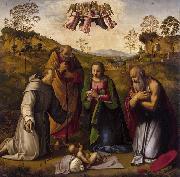 |
Ridolfo del Ghirlandaio -- Click Here
|
|
Ridolfo Ghirlandaio (or Ghirlandajo) (14 February 1483 - 6 June 1561) was an Italian painter of the Renaissance, active mainly in Florence, the son of Domenico Ghirlandaio.
He was born in Florence. Being less than eleven years old when his father died, Ridolfo was brought up by his uncle Davide Ghirlandaio, a painter of moderate talents. Vasari states that Ridolfo trained under Fra Bartolomeo.
His works between the dates 1504 and 1508 show a marked influence from Fra Bartolomeo and Raphael, with whom he was friends. From Rome in 1508, Raphael asked Ridolfo to join him; but the Florentine painter stayed. In Florence, he became one of the prominent painters of altarpieces, frescoes, and portraits.
He was prominent in the execution of vast scenic canvases for various public occasions, such as the wedding of Giuliano de' Medici, and the entry of Leo X into Florence in 1515. In his prime he was honest and conscientious as an artist; but from about 1527 he declined, having already accumulated a handsome property, more than sufficient for maintaining in affluence his large family of fifteen children, and his works became comparatively mannered and repetitive. His sons traded in France and in Ferrara; he himself took a part in commercial affairs, and began paying some attention to mosaic work, but it seems that, after completing one mosaic, the Annunciation over the door of the Annunziata Basilica, patience failed him for continuing such minute labours. In his old age Ridolfo was greatly disabled by gout. He appears to have been of a kindly, easy-going character, much regarded by his friends and patrons.
Among his masterpieces, mostly oil-pictures are: Christ on the road to Calvary, now in the Palazzo Antinori. An Annunciation in the Abbey of Montoliveto near Florence, Leonardesque in style. In 1504, he completed the Coronation of the Virgin. He painted a Nativity and a predella in the oratory of the Bigallo, Florence, five panels, representing the Nativity and other subjects. In 1514, on the ceiling of the chapel of St Bernard in the Palazzo Pubblico, Florence, a fresco of the Trinity, with heads of the twelve apostles and other accessories, and the Annunciation; also an Assumption of the Virgin, who bestows her girdle on St Thomas, in the choir loft of Prato cathedral. |
|
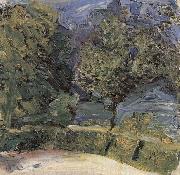 |
Richard Gerstl -- Click Here
|
|
(September 14, 1883 - November 4, 1908) was an Austrian painter and draughtsman known for his expressive psychologically insightful portraits, his lack of critical acclaim during his lifetime, and his affair with the wife of Arnold Schoenberg which led to his suicide.
Richard Gerstl was born in a prosperous civil family, Emil Gerstl, a Jewish merchant, and Maria Pfeiffer, non-Jewish woman. He visited the Viennese Piaristengymnasium (de) (Bundesgymnasium Wien 8 (de), Josefstadt), but he had to leave because of difficulties of discipline.
Early in his life, Gerstl decided to become an artist, much to the dismay of his father. After performing poorly in school and being forced to leave the famed Piaristengymnasium in Vienna as a result of "disciplinary difficulties," his financially stable parents provided him with private tutors. In 1898, at the age of fifteen, Gerstl was accepted the Academy of Fine Arts Vienna where he studied under the notoriously opinionated and difficult Christian Griepenkerl. Gerstl began to reject the style of the Vienna Secession and what he felt was pretentious art. This eventually prompted his vocal professor to proclaim, "The way you paint, I piss in the snow!"
Frustrated with the lack of acceptance of his non-secessionist painting style, Gerstl continued to paint without any formal guidance for two years. For the summers of 1900 and 1901, Gerstl studied under the guidance of Simon Hollesy in Nagybenya. Inspired by the more liberal leanings of Heinrich Lefler (de), Gerstl once again attempted formal education. Unfortunately, his refusal to participate in a procession in honor of Emperor Franz Joseph I of Austria further ostracized him and led to his departure. Gerstl felt that taking part in such an event was "unworthy of an artist." His final exit from Lefler's studio took place in 1908.
In 1904 and 1905, Gerstl shared a studio with his former academy classmate and friend, Viktor Hammer. Although Hammer had assisted in Gerstl's admittance to Lefler's tutelage and their relationship was friendly, it is difficult to determine how close the two men were as Gerstl did not associate with other artists. Regardless of their personal feelings, by 1906, Gerstl had acquired his own studio.
Although Gerstl did not associate with other artists, he did feel drawn to the musically inclined; he himself frequented concerts in Vienna. Around 1907, he began to associate with composers Arnold Schoenberg and Alexander von Zemlinsky, who lived in the same building at the time. Gerstl and Schoenberg developed a mutual admiration based upon their individual talents. Gerstl apparently instructed Schoenberg in art.
|
|
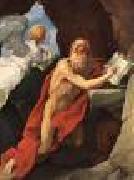 |
RENI, Guido -- Click Here
|
|
Italian Baroque Era Painter, 1575-1642
Italian painter, draughtsman and etcher. He was one of the greatest and most influential of the 17th-century Italian painters, whose sophisticated and complex art dominated the Bolognese school. A classicizing artist, deeply influenced by Greco-Roman art and by Raphael but also by the mannered elegance of Parmigianino's paintings, he sought an ideal beauty; his work was especially celebrated for its compositional and figural grace. In his religious art he was concerned with the expression of intense emotion, often charged with pathos; according to his biographer Malvasia, he boasted that he 'could paint heads with their eyes uplifted a hundred different ways' to give form to a state of ecstasy or divine inspiration. |
|
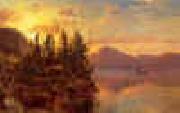 |
Regis-Francois Gignoux -- Click Here
|
|
1816-1882
French/American
Regis-Francois Gignoux Gallery
French painter who was active in the United States from 1840 to 1870. He was born in Lyon, France and studied at the École des Beaux-Arts under with the French painter Paul Delaroche (1797-1856). Gignoux arrived in the United States from France in 1840 and opened a studio in Brooklyn, New York. He was a member of the National Academy of Design, and was the first president of the Brooklyn Art Academy. George Inness (1825-1894) and John LaFarge (1835-1910) were both his students. Gignoux was the only member of the Hudson River School to specialize in snow scenes. He returned to France in 1870 and died in Paris in 1882.
The Brooklyn Museum, the Corcoran Gallery of Art (Washington, DC), the Georgia Museum of Art (University Of Georgia, Athens), the High Museum of Art (Atlanta, Georgia), the Honolulu Academy of Arts, the Hood Museum of Art (Dartmouth College, Hanover, New Hampshire), the Museum of Art at Brigham Young University (Provo, Utah), the Museum of Fine Arts, Boston, the Nelson-Atkins Museum of Art (Kansas City, Missouri), the New York Historical Society (New York City), the Parrish Art Museum (Southampton, New York), Smith College Museum of Art (Northampton, Massachusetts), the United States Capital Art Collection (Washington, D. C.), the Walters Art Museum (Baltimore, Maryland) and the Watson Gallery (Wheaton College, Norton, Massachusetts) are among the public collections holding work by R??gis François Gignoux. |
|
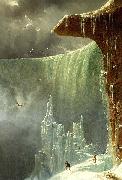 |
Regis Francois Gignoux -- Click Here
|
|
Regis François Gignoux (1816-1882) was a French painter who was active in the United States from 1840 to 1870. He was born in Lyon, France and studied at the École des Beaux-Arts under the French historical painter Hippolyte Delaroche, who inspired Gignoux to turn his talents toward landscape painting. Gignoux arrived in the United States from France in 1840 and eventually opened a studio in Brooklyn, New York. He was a member of the National Academy of Design, and was the first president of the Brooklyn Art Academy. George Inness, John LaFarge (1835-1910), and Charles Dormon Robinson were his students. By 1844, Gignoux had opened a studio in New York City and became one the first artists to join the famous Tenth Street Studio, where other members included Albert Bierstadt, Frederic Church, Jasper Francis Cropsey, and John Frederick Kensett. He returned to France in 1870 and died in Paris in 1882.
|
|
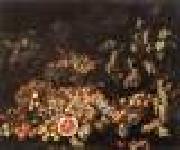 |
RECCO, Giuseppe -- Click Here
|
|
Italian Baroque Era Painter, 1634-1695
Son of Giacomo Recco. He was the most celebrated Neapolitan still-life painter of his day. He began in the tradition of his father and (probable) uncle Giovan Battista Recco, painting naturalistic arrangements of flowers, fish, game and kitchen scenes. There are many signed and dated works which chart the development of his style. The Bodeg?n with a Negro and Musical Instruments (1659; Madrid, Medibacoeli priv. col.), the Bodeg?n with Fish (1664; Paris, Moret priv. col.) and the Kitchen Interior (1675; Vienna, Ksthist. Mus.) are close to the art of Giovan Battista Recco. The fish and kitchen still-lifes are typically Neapolitan, yet Giuseppe's art is distinguished by the intensity with which he observes light and surface texture and by the clarity of the composition, based on a careful balance of horizontals and verticals. He moved toward a more Baroque and decorative style, and the unfinished Still-life with Fruit, Flowers and Birds (1672) and the Still-life with Fruit and Flowers
|
|
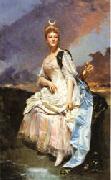 |
Raimundo de Madrazo y Garreta -- Click Here
|
|
Spanish realist Painter , 1841-1920
Son of Federico de Madrazo y K?ntz. Because of his ability and training with his father, Federico, in the Real Academia de S Fernando in Madrid and with L?on Cogniet in Paris, he seemed destined to continue the family tradition of academic painting. However, due to the influence of the Belgian Alfred Stevens, of his brother-in-law, Mariano Jos? Bernardo Fortuny y Marsal, and the Parisian environment, he exchanged dry historical painting (e.g. Arrival in Spain of the Body of the Apostle St James, 1858, and Ataulfo, 1860) for the preciousness of the tableautin, the small, intimate genre painting. He lived in Paris and New York and became so remote from Spanish artistic life that he and Fortuny y Marsal were the only Spanish artists not to participate in any national exhibition, and because of this the Spanish state never directly acquired their works. In 1882, with Giuseppe De Nittis, Stevens and the gallery owner Georges Petit, he co-founded the Exposition Internationale de Peinture, designed to promote foreign artists in Paris. Madrazo Garreta's most characteristic works are the female portrait and the witty and elegant genre painting, with soft, delicate tones and suggestive poses. The influence of the Rococo and of Japanese art is reflected in his painting, which expresses an exquisite aristocratic or bourgeois ideal, the illusion of a refined, sensual and superficial life. Consequently, |
|
 |
Raimundo de Madrazo y Garreta -- Click Here
|
|
1841-1920
Spanish
Son of Federico de Madrazo y Kentz. Because of his ability and training with his father, Federico, in the Real Academia de S Fernando in Madrid and with Leon Cogniet in Paris, he seemed destined to continue the family tradition of academic painting. However, due to the influence of the Belgian Alfred Stevens, of his brother-in-law, Mariano Jose Bernardo Fortuny y Marsal, and the Parisian environment, he exchanged dry historical painting for the preciousness of the tableautin, the small, intimate genre painting. He lived in Paris and New York and became so remote from Spanish artistic life that he and Fortuny y Marsal were the only Spanish artists not to participate in any national exhibition, and because of this the Spanish state never directly acquired their works. In 1882, with Giuseppe De Nittis, Stevens and the gallery owner Georges Petit, he co-founded the Exposition Internationale de Peinture, designed to promote foreign artists in Paris. Madrazo Garreta most characteristic works are the female portrait and the witty and elegant genre painting, with soft, delicate tones and suggestive poses. The influence of the Rococo and of Japanese art is reflected in his painting, which expresses an exquisite aristocratic or bourgeois ideal, the illusion of a refined, sensual and superficial life. Consequently, his works are also described as representing the Parisian seraglio. American collectors paid high prices for his paintings, for example Alexander Turney Stewart bought Lady with a Parrot; Carnival Festival (1878) was purchased by L. Wolfe; and Girls at the Window (1875) was bought by J. W. Vanderbilt, the last two now being in the Metropolitan Museum of Art, New York. His portraits were better received in Spain although because of collectors such as Ramen de Errazu (d 1909), the Museo del Prado has a good number of his paintings (e.g. After the Bath). |
|
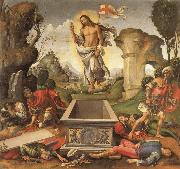 |
Raffaellino del garbo -- Click Here
|
|
Italian Early Renaissance Painter , ca.1466-1524
Italian painter and draughtsman. According to Vasari, he began as the most gifted assistant of Filippino Lippi and the most promising painter of the new generation but never fulfilled expectations, deteriorating into mediocrity and worse. Raffaellino's first known work is the frescoed vault of a small antechamber off Filippino Lippi's Carafa Chapel in S Maria sopra Minerva, Rome, uncovered during restoration in the 1960s. It was decorated with pagan themes, to Filippino's designs, apparently after the main chapel was completed in 1493. Filippino's influence is evident in the all'antica detail and animated figure style, to which Raffaellino brought a youthful freshness and charm. Vasari, in his account of the vault, likened it to an illuminator's work. It has been suggested that Raffaellino remained in Rome and worked with Bernardino Pinturicchio in the Borgia apartments in the Vatican, where some frescoes of 1495 show stylistic affinities with Raffaellino's work in S Maria sopra Minerva. |
|
|